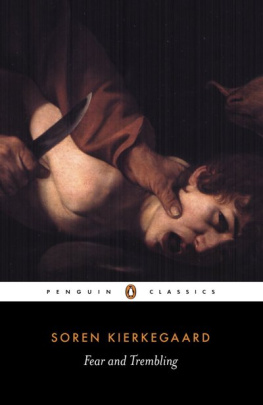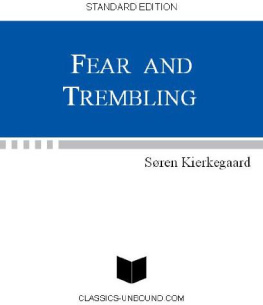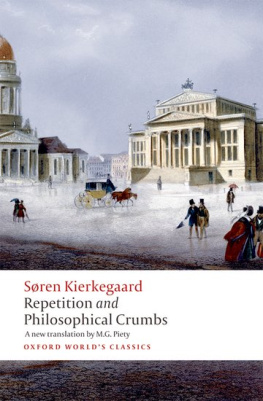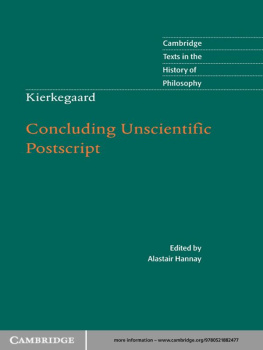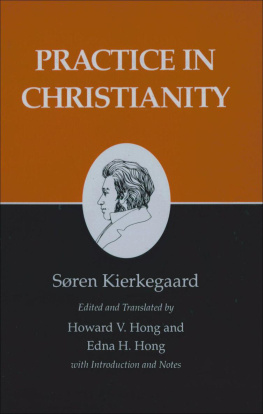FEAR AND TREMBLING
SREN AABYE KIERKEGAARD was born in Copenhagen in 1813, the youngest of seven children. His mother, his sisters and two of his brothers all died before he reached his twenty-first birthday. Kierkegaard's childhood was an isolated and unhappy one, clouded by the religious fervour of his father. He was educated at the School of Civic Virtue and went on to enter the university, where he read theology but also studied the liberal arts and science. In all, he spent seven years as a student, gaining a reputation both for his academic brilliance and for his extravagant social life. Towards the end of his university career he started to criticize the Christianity upheld by his father and to look for a new set of values. In 1841 he broke off his engagement to Regine Olsen and devoted himself to his writing. During the next ten years he produced a flood of discourses and no fewer than twelve major philosophical essays, many of them written under noms de plume . Notable are Either / Or (1843), Repetition (1843), Fear and Trembling (1843), Philosophical Fragments (1844), The Concept of Anxiety (1844), Stages on Life s Way (1845), Concluding Unscientific Postscript (1846) and The Sickness unto Death (1849). By the end of his life Kierkegaard had become an object of public ridicule and scorn, partly because of a sustained feud that he had provoked in 1846 with the satirical Danish weekly the Corsair , partly because of his repeated attacks on the Danish State Church. Few mourned his death in November 1855, but during the early twentieth century his work enjoyed increasing acclaim and he has done much to inspire both modern Protestant theology and existentialism. Today Kierkegaard is attracting increasing attention from philosophers and writers inside and outside the postmodern tradition.
ALASTAIR HANNAY was born to Scottish parents in Plymouth, Devon, in 1932 and educated at the Edinburgh Academy, the University of Edinburgh and University College London. In 1961 he became a resident of Norway, where he is now Emeritus Professor of Philosophy at the University of Oslo. A Fellow of the Royal Society of Edinburgh, he has been a frequent visiting professor at the University of California, at San Diego and at Berkeley. Alastair Hannay has also translated Kierkegaard's Either / Or , The Sickness unto Death , Papers and Journals and A Literary Review for Penguin Classics. His other publications include Mental Images A Defence , Kierkegaard ( Arguments of the Philosophers ), Human Consciousness and Kierkegaard : A Biography , as well as articles on diverse themes in philosophical collections and journals. He is the editor of Inquiry .
KIERKEGAARD

FEAR AND TREMBLING
Dialectical Lyric by
Johannes de silentio

Translated with an introduction by
Alastair Hannay
PENGUIN BOOKS
PENGUIN BOOKS
Published by the Penguin Group
Penguin Books Ltd, 80 Strand, London WC2R 0RL, England
Penguin Putnam Inc., 375 Hudson Street, New York, New York 10014, USA
Penguin Books Australia Ltd, 250 Camberwell Road, Camberwell, Victoria 3124, Australia
Penguin Books Canada Ltd, 10 Alcorn Avenue, Toronto, Ontario, Canada M4V 3B2
Penguin Books India (P) Ltd, 11 Community Centre, Panchsheel Park, New Delhi 110017, India
Penguin Books (NZ) Ltd, Cnr Rosedale and Airborne Roads, Albany, Auckland, New Zealand
Penguin Books (South Africa) (Pty) Ltd, 24 Sturdee Avenue, Rosebank 2196, South Africa
Penguin Books Ltd, Registered Offices: 80 Strand, London WC2R 0RL, England
www.penguin.com
This translation first published 1985
Reprinted with a new Chronology 2003
Copyright Alastair Hannay, 1985
All rights reserved
Except in the United States of America, this book is sold subject to the condition that it shall not, by way of trade or otherwise, be lent, re-sold, hired out, or otherwise circulated without the publisher's prior consent in any form of binding or cover other than that in which it is published and without a similar condition including this condition being imposed on the subsequent purchaser
978-0-141-90623-2
CONTENTS
INTRODUCTION
God said to Abraham, go kill me a son.
Abe said, Man, you must be puttin' me on.
BOB DYLAN, Highway 61
The Old Testament story of Abraham's journey to the mountain to sacrifice Isaac has been read in widely different ways. It was used by the early Christian Church to celebrate faith and obedience. The focus then was on Abraham and his unreserved submission to God's will. In Jewish culture the story was later used to invoke God's mercy: instead of the hand raised in sacrifice, it was the staying of the hand that assumed importance, when the angel said, Lay not thine hand upon the lad, neither do thou any thing unto him. Faith, obedience, and mercy are social virtues. For a modern consciousness the story is likely to be read as an anti-social parable of destruction and raw power. The opening verse of Bob Dylan's song concludes, God said, you can do what you want, Abe, but next time you see me comin', you'd better run. Well, Abe said, where you want this killin' done? God said, do it on Highway 61'. Faith, obedience, and mercy have here given way to disbelief, arbitrariness, and intimidation.
Abraham's journey is the centrepiece of Kierkegaard's Fear and Trembling . But Kierkegaard's focus, as originally, is on Abraham; Isaac is little more than a foil to Abraham's greatness. Yet this greatness is not, as in the traditional reading, Abraham's willingness to be an instrument of God's omnipotence. Kierkegaard's Abraham is great because of what he suffers in a trial of faith. And far from epitomizing social virtues, this Abraham's suffering and greatness seem to isolate him in a very radical way from his society and its social ways. In impressing us with Abraham's greatness Kierkegaard has a very special purpose. In fact one can safely say that Fear and Trembling is not primarily concerned with the story of Abraham and Isaac at all; it uses the story in order to draw the reader's attention to certain very fundamental questions. The work has a polemical purpose and to carry it out Kierkegaard requires us to focus on the nature of the suffering involved in the story. In this introduction I shall explain these features more fully, indicating in some detail the background to Kierkegaard's writings.
Fear and Trembling first appeared in Copenhagen bookshops on 16 October 1843, along with a companion work, Repetition , and a collection of Edifying Discourses. The first two works were written under false names, Johannes de silentio and Constantin Constantius, a practice followed by Kierkegaard in all the works he later called his aesthetic production, from Either / Or (1843) to Practice in Christianity (1850). According to its subtitle, Fear and Trembling is a dialectical lyric. That doesn't mean that Fear and Trembling is a mainly literary work to be judged by standards of style and presentation, or its topic largely a medium for the artistic development of a literary talent. Since it does call itself a lyric, however, we would certainly expect its author to want his handiwork to be judged at least partly by such standards. Indeed all of Kierkegaard's aesthetic works are products of someone obviously delighting in his native literary talent. But to read them as purely literary exercises would be misconceived as well as frustrating. Misconceived because, far from being a mere vehicle for literary expression, their themes are very obviously the author's main concern throughout, and where the style may be called literary, that fact is to be seen rather in the light of the author's chosen way of bringing those themes to light. Frustrating because unless the reader gets a firm hold of the theme and its not always immediately transparent ramifications, much of the work will defy the kind of immediate recognition of meaning on which literary presentation depends.

